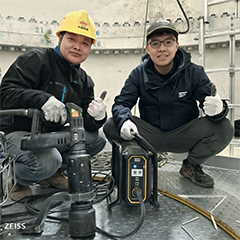Bolted joint assemblies are a critical part of a wind turbine as they have a direct impact on the structural integrity and the performance of the turbines. Applications can be found in all parts of the turbine such as foundations, tower flanges, nacelle, blades and internal components where the bolted joint must be secured according to specific design specifications and must remain secure throughout the turbines life cycle, despite exposure to temperature fluctuations, routine maintenance and repairs, and constant forces being exerted through the movement of the turbine and effects of wind itself.
There are many bolts to be tightened, and for the most part they are all critical
However, when it comes to tools and equipment used in the bolting process, the wind sector in general has been somewhat conservative in the types of tooling used, with much tooling being used today having not evolved in any significant way for many years, even decades. In-fact, there has been a tendency to standardise on the same type of solutions for many years, despite the fact that both the industry demands, and available technology is evolving at pace.
The reason for this is quite simple. Bolting tools are usually specified by the OEM when a turbine design is made, and then this is standardised in the standard operating procedures which are then pushed out to all stakeholders, such as contractors or service companies working on the turbines during their life. Then when new designs are introduced, it is based on the previous generation, resulting in tool fleets which are built up over a number of years meaning large tool inventories are in place, and so there is a resistance to introduce new solutions which may require additional investment, and could render existing tool fleets redundant.
The result is that the bolting process today is more demanding than ever with new turbine design involving new materials, more optimised joints and continuous demand for increased cost efficiency, however the tooling used on these joints is largely the same as it has been for many years.
Interestingly, inside the manufacturing facilities of the Wind OEM’s where for example nacelles takes place, then in many cases the latest technology such advanced electric nutrunner solutions, data collection systems and even automation are fairly commonplace for all bolted assembly work on the assembly lines as this offers the highest productivity output combined with a consistent high-quality result. This is well established, and in recent years with the arrival of Industry 4.0, we see an acceleration of these types of solutions where most assembly tools in the factories are not only ‘smart’ in that they have intelligence built in, but they are also now ‘connected’, where they integrated for example to a to an MES systems in the plant.



























